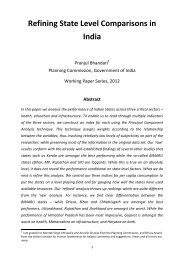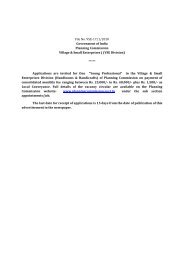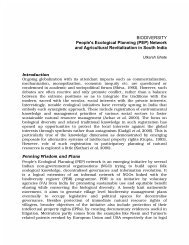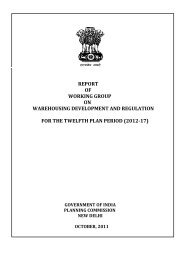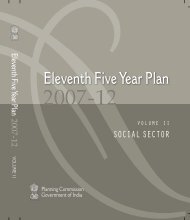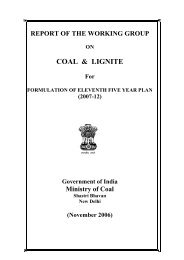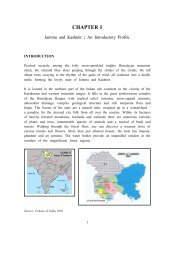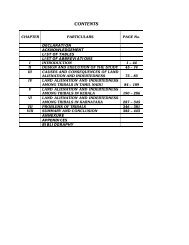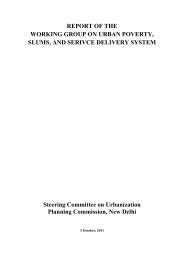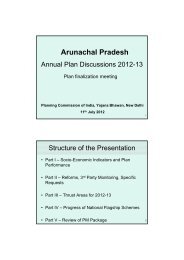Approach Paper for the Twelfth Five Year Plan - of Planning ...
Approach Paper for the Twelfth Five Year Plan - of Planning ...
Approach Paper for the Twelfth Five Year Plan - of Planning ...
Create successful ePaper yourself
Turn your PDF publications into a flip-book with our unique Google optimized e-Paper software.
20 <strong>Approach</strong> to <strong>the</strong> <strong>Twelfth</strong> <strong>Five</strong> <strong>Year</strong> <strong>Plan</strong><br />
2.16 There was also a purely domestic factor at play. In <strong>the</strong> Ninth <strong>Plan</strong> (1997-98 to 2001-02) <strong>the</strong><br />
rate <strong>of</strong> GDP growth was subdued at 5.5 per cent and <strong>the</strong> incremental capital output ratio (ICOR),<br />
notwithstanding comparatively lower investment rates, was ra<strong>the</strong>r high at 4.5 per cent, as it also was in <strong>the</strong><br />
first two years <strong>of</strong> <strong>the</strong> Tenth <strong>Plan</strong> (2002-03 and 2003-04) at 4.9 per cent. This flowed from slower growth<br />
in domestic demand during <strong>the</strong>se years, and as a result India had a persistent current account surplus<br />
<strong>for</strong> three successive years from 2001-02 to 2003-04. There was thus some slack in <strong>the</strong> system, which got<br />
utilized in <strong>the</strong> Tenth <strong>Plan</strong> period. This should be borne in mind when viewing investment and growth<br />
rates realized in <strong>the</strong> Tenth <strong>Plan</strong>.<br />
2.17 The current account balance slipped back into negative in 2004-05 and averaged (–) 0.9 per cent<br />
<strong>of</strong> GDP in <strong>the</strong> last three years <strong>of</strong> <strong>the</strong> Tenth <strong>Plan</strong>. On account <strong>of</strong> <strong>the</strong> large surpluses in <strong>the</strong> first two years<br />
<strong>of</strong> <strong>the</strong> Tenth <strong>Plan</strong>, <strong>the</strong> average current account deficit <strong>for</strong> <strong>the</strong> five year period was nil. The Eleventh <strong>Plan</strong><br />
period did not start out with <strong>the</strong> benefit <strong>of</strong> a slack in <strong>the</strong> system, as did <strong>the</strong> Tenth. One consequence <strong>of</strong><br />
this was that despite <strong>the</strong> high investment rates that were realized during <strong>the</strong> closing years <strong>of</strong> <strong>the</strong> Tenth, and<br />
early years <strong>of</strong> <strong>the</strong> Eleventh <strong>Plan</strong>, inflation came to be a persistent problem.<br />
2.18 While <strong>the</strong>re are specific sectoral bottlenecks that explain some <strong>of</strong> <strong>the</strong> inflationary pressures, at <strong>the</strong><br />
aggregate level, resolving <strong>the</strong>se bottlenecks requires additional investment. Hence, in order to sustain high<br />
rates <strong>of</strong> growth per centwhile maintaining moderate inflation, investment rate has to be higher than in <strong>the</strong><br />
past, especially in areas where supply side bottlenecks could trigger inflation. Thus <strong>the</strong> average investment<br />
rate needed during <strong>the</strong> <strong>Twelfth</strong> <strong>Plan</strong> period is estimated to be 38.5 per cent <strong>of</strong> GDP <strong>for</strong> <strong>the</strong> 9.0 per cent<br />
growth with 4.5–5.0 average inflation. The investment rate would have to rise to as much as 41.4 per cent<br />
<strong>of</strong> GDP <strong>for</strong> <strong>the</strong> 9.5 per cent growth with 5.0–5.5 rate <strong>of</strong> inflation.<br />
2.19 The rate <strong>of</strong> fixed capital <strong>for</strong>mation had increased rapidly during <strong>the</strong> Tenth <strong>Plan</strong>. It averaged around<br />
28.4 per cent <strong>of</strong> GDP over <strong>the</strong> Tenth <strong>Plan</strong> period as against 23.2 per cent <strong>of</strong> GDP in <strong>the</strong> Ninth <strong>Plan</strong>. It<br />
had risen to 32.9 per cent <strong>of</strong> GDP in 2007-08, after which it declined through <strong>the</strong> years <strong>of</strong> <strong>the</strong> crisis to<br />
29.5 per cent (provisional) in 2010-11. Even so, <strong>the</strong> rate <strong>of</strong> fixed capital <strong>for</strong>mation is likely to average<br />
around 31 per cent <strong>of</strong> GDP in <strong>the</strong> Eleventh <strong>Plan</strong>, which is 2.6 per centage points <strong>of</strong> GDP higher than<br />
in <strong>the</strong> Tenth <strong>Plan</strong>. As pointed out above, <strong>the</strong> pick up in <strong>the</strong> average rate <strong>of</strong> growth in <strong>the</strong> Eleventh <strong>Plan</strong><br />
period was not fully commensurate with this increase partly due to external developments. Fur<strong>the</strong>r in<br />
order to sustain high growth while keeping inflation within moderate limits, it is imperative to expand <strong>the</strong><br />
productive potential <strong>of</strong> <strong>the</strong> economy at a faster rate. In order to achieve an average economic growth rate <strong>of</strong><br />
9.0 per cent, <strong>the</strong> rate <strong>of</strong> fixed capital <strong>for</strong>mation needs to improve to around 33.5 per cent <strong>of</strong> GDP over <strong>the</strong><br />
<strong>Twelfth</strong> <strong>Plan</strong> period. This is feasible considering that a fixed capital <strong>for</strong>mation rate <strong>of</strong> 32.9 per cent was<br />
actually achieved in 2007-08.<br />
2.20 For <strong>the</strong> 9 per cent economic growth scenario, <strong>the</strong> likely break-up <strong>of</strong> fixed capital <strong>for</strong>mation by<br />
investing sector shows some interesting features:<br />
(i) Fixed capital <strong>for</strong>mation in <strong>the</strong> household sector (which, in addition to agriculture and<br />
residential construction, includes practically all <strong>the</strong> micro and small enterprises) has been<br />
ra<strong>the</strong>r stable, and are projected to increase to 12.0 per cent <strong>of</strong> GDP in <strong>the</strong> <strong>Twelfth</strong> <strong>Plan</strong> from<br />
11.6 per cent <strong>of</strong> GDP during <strong>the</strong> Eleventh <strong>Plan</strong>. For this to happen, <strong>the</strong> flow <strong>of</strong> financial<br />
resources to <strong>the</strong>se sectors has to increase significantly. This would require not only expansion<br />
<strong>of</strong> <strong>the</strong> reach <strong>of</strong> <strong>the</strong> <strong>for</strong>mal banking sector, but also revitalisation <strong>of</strong> <strong>the</strong> micro finance and o<strong>the</strong>r<br />
innovative financial institutions.



